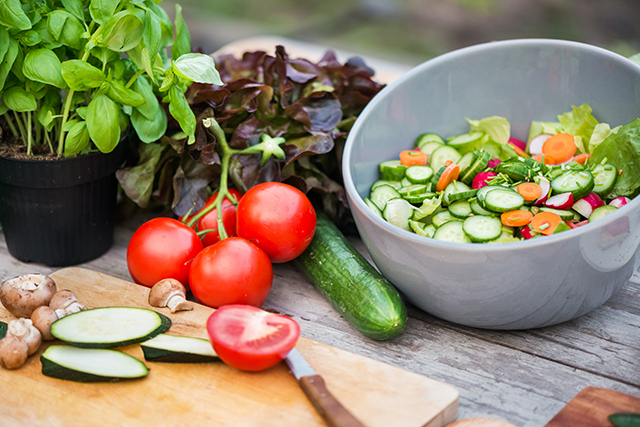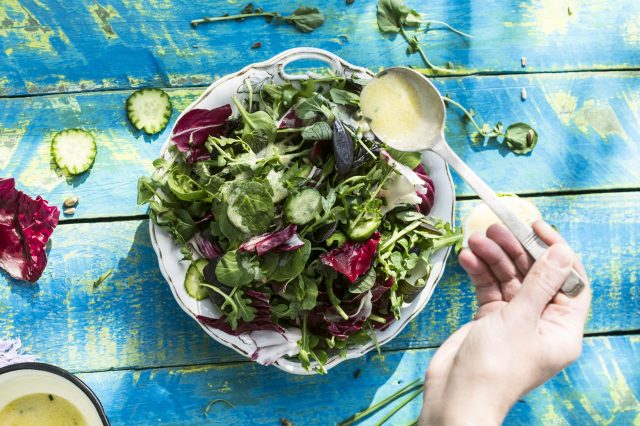Are you ready for the best salad ever?
Gone are the days of salads being seen solely as boring diet food. Salads can be tasty, filling and exciting – all while being healthy, too!
Upgrade your greens with these tips.
Base
Use a variety of lettuces and greens to get the best balance of flavors, textures and nutrition. The greener the better. Many dark, leafy greens contain vitamin A, vitamin C and calcium. Lettuces like iceberg and romaine don’t have as much flavor or nutritional value, but they do add a nice crunch.
Not all greens are the same when it comes to flavor. Greens like arugula and watercress are peppery while Swiss chard is earthy. Spinach tastes a little “green” but is relatively mild. Kale has a hearty leaf and tastes a little bitter, but baby kale will be a bit milder. Dandelion greens are nutty and a touch bitter, but anyone with a latex allergy should avoid this plant.
Give it Body
Bulk up your greens with plenty of veggies, fruits and other plants. Classic salad toppings like carrot, cucumber and tomato are popular, but there are plenty of other options to add colors, flavors and textures. Use what’s in season or fresh from your garden and get creative!
Flavors
Additions like bell pepper, onion and radish add pops of flavor and additional health benefits. Bell peppers are packed with vitamin C while onions and radishes are rich in other nutrients. Additional salad-friendly flavor bombs include briny olives and earthy beets.
Fruit can be another tasty addition. Dried fruits like cherries, cranberries and blueberries are sweet, tart and chewy. Fresh fruits like grapes, mandarin oranges and strawberries add a juicy burst of flavor.
Of course, fruits contain natural sugars, so you don’t want to go overboard. On the plus side, they also offer some health benefits. Berries are rich in antioxidants while fruits like apple, grapefruit and pineapple contain other vitamins and minerals.
Textures
The best salads have great texture. Ingredients like cabbage and celery add crunch. Though they don’t offer much in terms of flavor, both are low in calories. Crunchy additions like fresh broccoli and shredded brussels sprouts give salads a bit more character.
On the other end of the spectrum, there are superfoods like avocado and mushrooms. Avocado adds a creamy texture and healthy monounsaturated fatty acids. Mushrooms offer a soft, slightly chewy texture while boasting vitamins, minerals and antioxidants. Mushrooms are also said to be probiotic and cancer-fighting.
Proteins
Adding a bit of protein to your salad can upgrade it from appetizer to full meal.
Plant-Based Protein
Eating less meat reduces the risk of heart disease, high blood pressure, high cholesterol, many cancers, obesity, stroke and type 2 diabetes, according to the American Heart Association. Try a plant-based protein like tofu or seitan.
Legumes
Legumes include beans and lentils. Beans like black, kidney and pinto are packed with protein and fiber. Beans like garbanzo/chickpeas can be roasted until crispy, making them a healthy alternative to croutons. Lentils come in different color varieties (like brown, green, red, etc.) that are high in protein and iron.
Animal Protein
Many animal products come with saturated fat and cholesterol. Use small portions of lean meat like grilled chicken, and seafood like tuna and salmon for omega-3 fatty acids. Add an egg to your salad for extra protein, but choose healthier preparations like hard/soft-boiled or poached.
Quinoa
Not only is quinoa high in protein and fiber and gluten-free, it’s one of the few plants that’s considered a complete protein. This means “it contains all nine essential amino acids that our bodies cannot make on their own,” according to the Harvard School of Public Health. The three varieties of quinoa (black, red and white) have slightly different flavor profiles, but quinoa is generally rather bland. Rise your quinoa before cooking it and consider using a broth/stock instead of water to make it more flavorful. A pinch of spice like onion or garlic powder doesn’t hurt either.
Go for Garnishes
Nuts
Nuts offer healthy fat, fiber and protein while being packed with vitamins and minerals. Lightly toasted almonds, hazelnuts, peanuts, pecans and walnuts are all great in salads. Use unsalted nuts and only add about a handful, since they are high calorie.
Seeds
Poppy, chia, flax, pumpkin and sunflower seeds offer good crunch and tons of health benefits like fiber and healthy fats. Similar to nuts, try to use raw, unsalted seeds to get the most out of them.
Herbs
From mint to basil to cilantro, top your salad with fresh herbs to add in even more character and leafy green benefits.
Cheese
A sprinkle of cheese can add calcium, protein and extra flavor. Popular salad cheeses include blue, cheddar, feta, goat and mozzarella.

Dress to Impress
One of the unhealthiest parts of a salad can be the dressing. Store-bought dressings are often high in calories, fat and sugar while also containing artificial colors and sweeteners.
Make your own dressing with oil, your preferred vinegar (apple cider, balsamic, sherry, white, etc.) and a few herbs. Extra virgin olive oil is another super food and healthy fat that enhances salads.
If you can’t go without store-bought dressings, remember a vinaigrette is often healthier than dairy-based dressings like ranch. Regardless of which dressing you use, always measure out the correct serving size (2 tablespoons).
Types of Salads
Whether you’re throwing your favorite veggies into a bowl or following a recipe, the vast number of salads means there is something for everyone. Find your preferred salad by trying different kinds and making them your own.
Tossed and Composed Salads
Popular tossed salads include garden and Caesar. A garden/green salad is the iconic, simple salad you might find as a side at restaurants. Caesar salad features romaine lettuce, croutons, Parmesan and tangy dressing.
Composed salads include chef and Cobb. Chef salad is essentially a garden salad topped with hard-boiled egg and/or deli meat (ham, turkey, roast beef, etc.). Cobb salad includes a mix of lettuces with similar toppings to a chef salad, in addition to avocado and tomato.
If lettuce and/or leafy greens really aren’t your thing, consider salads with a base of slaw, broccoli or shredded brussels sprouts. Other less leafy and more vegetable-forward salads include Greek salad and Israeli salad. If you prefer fruit, consider a refreshing watermelon salad.
More of the Best Salads
Starchy or farinaceous salads are made with pasta, potatoes or grains like quinoa, farro, barley and rice. They often feature some chopped veggies and light dressing, but these carb-centered salads aren’t as healthy as their leafy counterparts.
Lastly are “bound” salads. Held together with a thicker dressing or mayonnaise, these include egg, tuna, chicken and seafood salads. While the mix of animal protein and heavier dressing does not make them the healthiest option, there is no denying that they are some of the best salads for special occasions.
What is your favorite type of salad? Tell us in the comments below.
10 Thoughts on “Build a Better Salad: Tips for Making the Best Salad Ever”
Leave A Comment
Comments are subject to moderation and may or may not be published at the editor’s discretion. Only comments that are relevant to the article and add value to the Your AAA community will be considered. Comments may be edited for clarity and length.
















Good Salad dressing?
Thanks for reading and commenting! A homemade vinaigrette with an oil and vinegar base is a good place to start.
Olive oil and balsamic vinegar with some garlic and a pinch of salt and pepper make a simple balsamic vinaigrette. You can use honey, Dijon mustard, apple cider vinegar and olive oil for a honey mustard dressing, or try making a homemade ranch using Greek yogurt.
I love salads and they comprise the base of my daily food intake. Not only are they delicious but they help to maintain a healthy weight. So this is a terrific article to encourage people to eat more salads and make them interesting, tasty and healthful.
I would just add that people should not be afraid of fruit! If you are diabetic or have other health issues check with your doctor or a qualified dietitian about the foods you should eat. But it is important to know that the sugar in fruit is metabolized more slowly than refined and concentrated sugars.
I prefer Boston, red and green leaf and butter lettuces and my favorite salad combos include: lettuce, organic apples and celery, carrots, seedless grapes, walnuts with two tablespoons of light blue-cheese dressing and a sprinkling of organic apple cider vinegar — and lettuce, avocado, tomato, green olives, endive, radicchio and scallions with an interesting vinegar (I love to experiment with different flavored vinegars), a squirt of fresh lime and organic EVOL from California. I pair either salad with a glass of iced water or herbal tea for lunch or a chilled California or New York white blended wine for dinner. If you are not watching your weight or just want to splurge a bit, add a crusty roll with some light butter or margarine. Enjoy!
Thanks for reading and commenting.
Those are all great ingredients for salads!
Loved all your ideas thanks
Those are all great ingredients for the various salads you listed. ‘Can’t wait to make my salad today! Thank you for the article. ????????????????????
I don’t know how those question marks appeared at the bottom of my first comment.
Excellent
Wow.. Absolutely loved reading this article. I am the forever, quintessential salad queen in my family, as I have declared publicly.. my favorite food item is “salad.” You nailed it as you so eloquently described the many possible components to building a delish salad, starting with yummy greens, complimented with enormous types of add-ons, depending upon one’s day-to- day, meal-to-meal palette. By now you know I am a super huge fan of the salad, as I incorporate salad into my daily meals/snacks practice. My refrigerator and pantry are forever evolving.. and so, daily salad creations are always happening!
Thanks for this opportunity to share.. salad lovers unite 🙂
Thank you for reading and commenting!
Salads really are amazing. I’m glad you enjoyed the article.